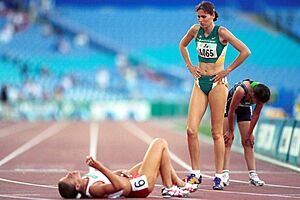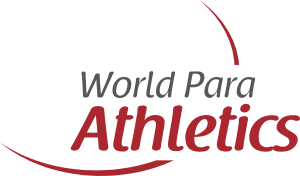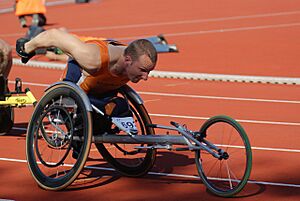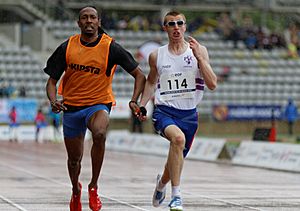Para-athletics facts for kids


Para-athletics is a cool sport where athletes with disabilities compete in events like running, jumping, and throwing. It's very similar to regular athletics, but with a few special rules and events to make it fair for everyone. You might also hear it called disability athletics or Paralympic athletics.
Some unique events in para-athletics include wheelchair racing, where athletes zoom around tracks in special chairs, and the club throw, which is a throwing event for certain athletes.
Athletes are usually grouped into categories based on their disability. This helps make sure competitions are fair. For example, there are groups for deaf athletes, athletes with physical disabilities, and athletes with intellectual disabilities.
To keep things fair, athletes with physical or intellectual disabilities get a special "classification." This groups athletes with similar abilities together. These classifications use a letter (like T for Track or F for Field) and a number to show their ability level.
The rules for para-athletics are mostly the same as for regular athletics. However, some rules are changed to help athletes. For example, deaf athletes might get a visual signal instead of a starting pistol to begin a race.
Para-athletics has been a part of the Paralympic Games since they started in 1960. Deaf athletes also have their own big event called the Deaflympics, and athletes with intellectual disabilities compete in the Special Olympics World Games.
The word "Para-athletics" comes from "Paralympic" and "athletics." The word "Paralympic" originally combined "paraplegic" and "Olympic," but now it means sports for all kinds of disabilities. Some para-athletes, like those with visual impairments or amputations, even compete in regular athletics events alongside able-bodied athletes!
Contents
How Athletes Compete Fairly: Classification
In big competitions, athletes are grouped by their disability. This is called "classification." It makes sure that athletes with similar abilities compete against each other, making the events exciting and fair.
Each athlete gets a classification code, like "T12." The letter tells you if they are a track athlete (T) or a field athlete (F). The number tells you about their disability and ability level.
Here are some examples of what the numbers mean:
- 11–13: These athletes have a visual impairment. Athletes in classes 11 and 12 often compete with a sighted guide who runs with them.
- 20: These athletes have an intellectual impairment.
- 31–38: These athletes have cerebral palsy, which affects movement and balance.
- 40-41: These athletes have dwarfism.
- 42–46: These athletes might have an amputation or other similar conditions.
- 51–57: These athletes compete in a wheelchair.
In wheelchair racing, athletes use special lightweight racing chairs. These athletes are incredibly fast! In many major marathons, wheelchair racers often finish the race faster than the runners on foot.
What Events Do Para-Athletes Compete In?
Para-athletes compete in many of the same events you see in regular athletics. Not every event is available for every classification, but there's a wide range of choices!
| Track Events | Road Events | Field Events | Combined Events | ||||
|---|---|---|---|---|---|---|---|
| Sprints | Middle-distance | Long-distance | Relays | Jumps | Throws | ||
| 100 m 200 m 400 m |
800 m 1500 m |
5000 m 10,000 m |
4 × 100 m relay 4 × 400 m relay |
Marathon | Long jump Triple jump High jump |
Shot put Discus throw Javelin throw Club throw |
Pentathlon |
World Para Athletics Grand Prix
The World Para Athletics Grand Prix is an exciting annual series of top-level track and field competitions. It brings together some of the best para-athletes from around the world. These events are important for developing the sport and helping athletes qualify for major championships like the Paralympics.
See also
- Athletics at the Summer Paralympics
- World Para Athletics Championships
- World Para Athletics Junior Championships
- Diamond League




